Logic Supply Core-ML320 Fanless Industrial NUC Review
by Ganesh T S on April 30, 2014 3:45 PM EST- Posted in
- NUC
- Industrial PC
- Passive Cooling
- Logic Supply
Performance Metrics - II
In this section, we mainly look at benchmark modes in programs used on a day-to-day basis, i.e, application performance and not synthetic workloads.
x264 Benchmark
First off, we have some video encoding benchmarks courtesy of x264 HD Benchmark v5.0.
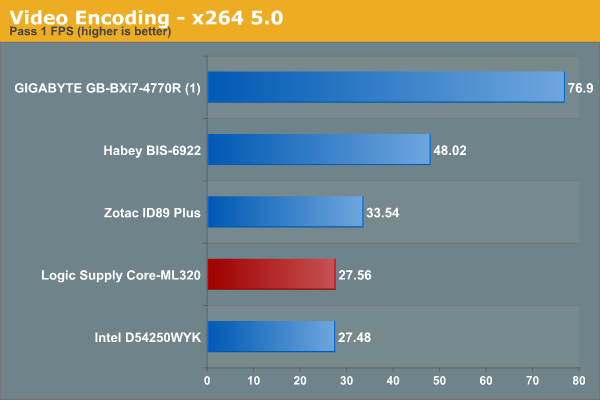
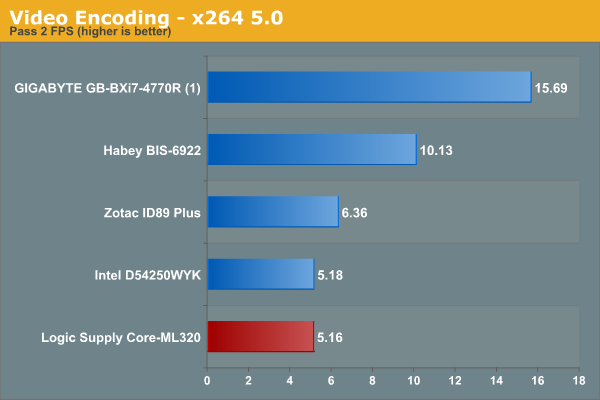
7-Zip
7-Zip is a very effective and efficient compression program, often beating out OpenCL accelerated commercial programs in benchmarks even while using just the CPU power. 7-Zip has a benchmarking program that provides tons of details regarding the underlying CPU's efficiency. In this subsection, we are interested in the compression and decompression MIPS ratings when utilizing all the available threads
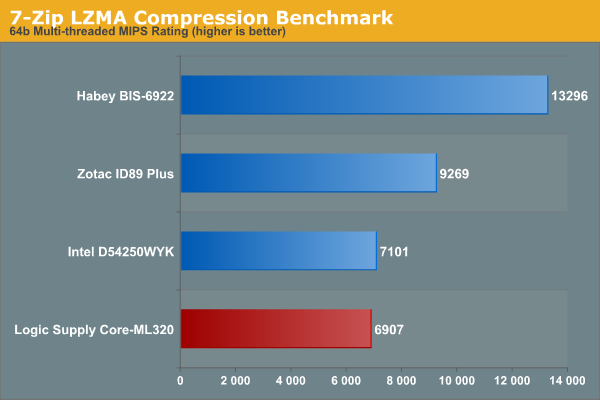

TrueCrypt
As businesses (and even home consumers) become more security conscious, the importance of encryption can't be overstated. CPUs supporting the AES-NI instruction for accelerating the encryption and decryption processes have, till now, been the higher end SKUs. However, with Bay Trail, even the lowly Atom series has gained support for AES-NI. The i5-4250U in the Core-ML320 has AES-NI support. TrueCrypt is a popular open-source disk encryption program which can take advantage of the AES-NI capabilities. The TrueCrypt internal benchmark provides some interesting cryptography-related numbers to ponder. In the graph below, we can get an idea of how fast a TrueCrypt volume would behave in the Core-ML320 and how it would compare with other select PCs.
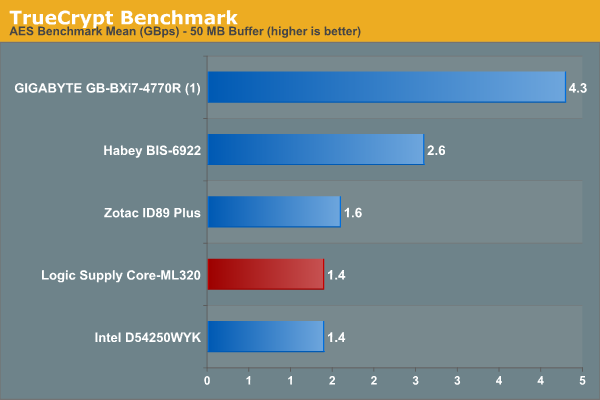
Agisoft Photoscan
Agisoft PhotoScan is a commercial program that converts 2D images into 3D point maps, meshes and textures. The program designers sent us a command line version in order to evaluate the efficiency of various systems that go under our review scanner. The command line version has two benchmark modes, one using the CPU and the other using both the CPU and GPU (via OpenCL). The benchmark takes around 50 photographs and does four stages of computation:
- Stage 1: Align Photographs
- Stage 2: Build Point Cloud (capable of OpenCL acceleration)
- Stage 3: Build Mesh
- Stage 4: Build Textures
We record the time taken for each stage. Since various elements of the software are single threaded, others multithreaded, and some use GPUs, it is interesting to record the effects of CPU generations, speeds, number of cores, DRAM parameters and the GPU using this software.
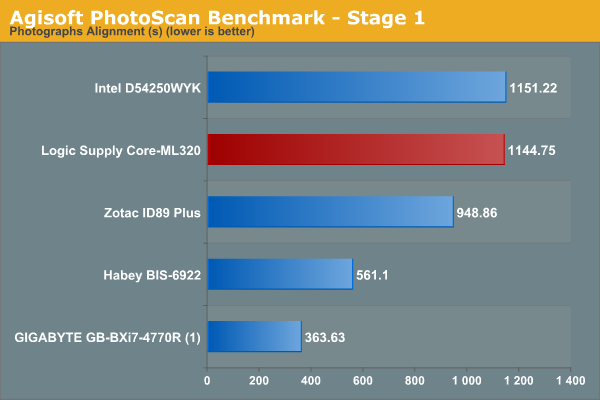
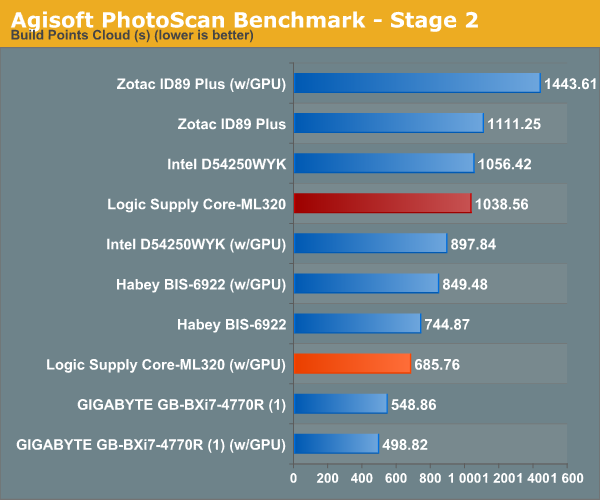
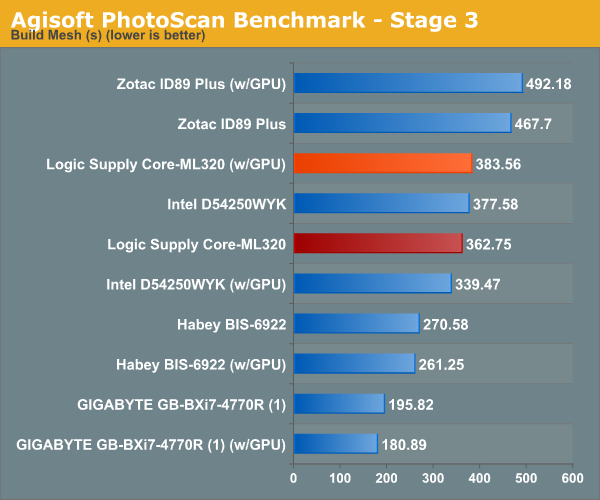
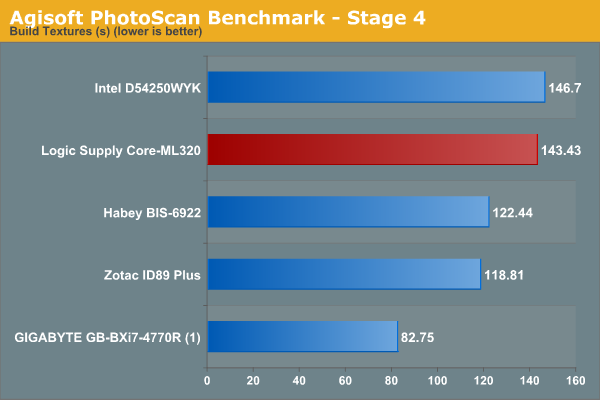
Dolphin Emulator
Wrapping up our application benchmark numbers is the Dolphin Emulator benchmark mode results.
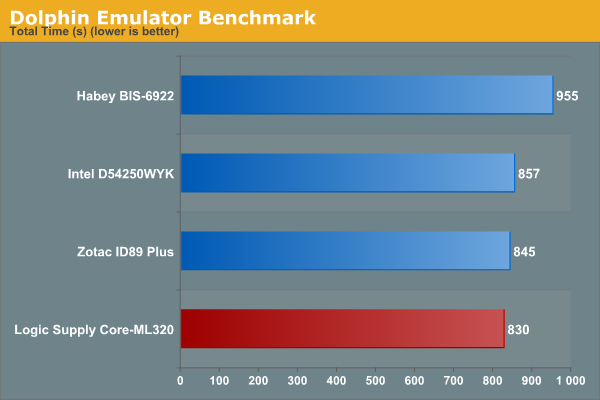










31 Comments
View All Comments
PCfan720 - Wednesday, April 30, 2014 - link
The base system is around $650, which is only a couple hundred bucks more than the standard NUC with a fan that Intel offers. A couple hundred bucks isn't bad for a completely sealed and fanless unit.WithoutWeakness - Thursday, May 1, 2014 - link
The NUC is also barebones. The price of comparable RAM and an MSATA SSD should be included in the price of the NUC for a fair comparison.eBob - Thursday, May 1, 2014 - link
This isn't really intended for a home or office user. When you have things running on the factory floor, reliability becomes a more overriding concern. These systems often end up running ten and even twenty years and often without software updates. I would imagine that a lot of these systems are destined to be locked in control cabinets with other hardware and forgotten about unless something goes wrong.Morawka - Thursday, May 1, 2014 - link
how did you build a NUC for under 300 when the barebones is $365? and that's not even counting $50 RAM, $70 Intel Wireless and $60 hard drive + $6 Power CordHrel - Wednesday, April 30, 2014 - link
What's gong on with the Habey on the 7zip test? Shouldn't Gigabyte still be way ahead?ganeshts - Wednesday, April 30, 2014 - link
We weren't able to run 7-Zip on the BRIX Pro (1) configuration because we no longer have access to that particular configuration. You can see updated benchmarks in our second part of the BRIX Pro review that will use different DRAM / storage. I will be posting that shortly.senthil.c - Wednesday, April 30, 2014 - link
It is very disappointing that most NUC does not comes with the IR sensor built-in, since these kind of PC's are mostly used in home theatre environment, IR sensor is a must needed feature.PCfan720 - Thursday, May 1, 2014 - link
The ML320 does have an IR sensor, it's pictured in the main image and listed in the spec table on the Logic Supply site (http://www.logicsupply.com/core-ml320/). Did you just mean that in general most NUC systems don't have one?Antronman - Wednesday, April 30, 2014 - link
Wouldn't make bad HTPCs.No IR, but not bad. A little bit on the pricey side though...for 1000-1300USD you're not looking at an HTPC, but a low-end gaming PC.
harshw - Thursday, May 1, 2014 - link
There's also the Akasa Newton H. It's smaller, cheaper ( in the UK at least. US prices are a laugh ) and with a bit of modding for LEDs - it is perfectly acceptable as a HTPCMine does 41c/50c for the CPU/SSD at an ambient of 27c
http://www.scan.co.uk/products/akasa-newton-h-alum...
The default LEDs for all these cases are usually a blindingly bright blue for power and an anemic green/yellow for HDD. I modded mine to have a warm daylight dim white LED for power and a dim blue for HDD activity. Wish manufacturers had more sense ...